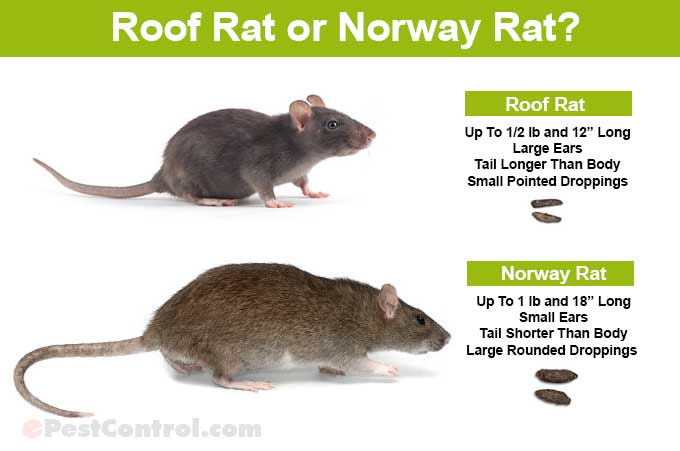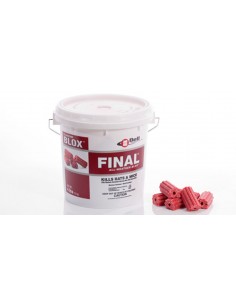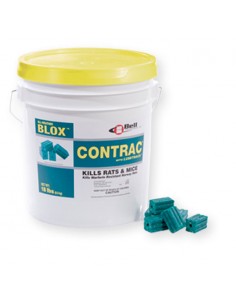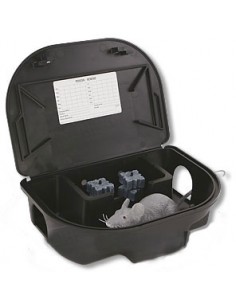Expert Help, Same-Day FREE Shipping & 60 Day Easy Returns - Since 1997
- Home
- About ePestSupply
- Contact Us
- Ask a Pro
- Q & A Library
- Orders & Shipping
- Hex Pro Termite Bait System
- Trelona® ATBS Annual Bait Stations and Advance® Termite Bait Stations
- KM Ant Pro
- KM AntPro®
- Ant Control Without Sprays in Vineyards, Agriculture, Food Crops and Zoos
- KM AntPro® Educational Videos
- How To Kill Ants
- Mice
- Rats
- Voles / Meadow Mice
- Mosquito Identification
- How To Kill Mosquitoes
- How To Kill Termites
- Asian
- House Cricket
- Field Cricket
- Mole Cricket
- Camel Cricket
- Jerusalem Cricket
- Snowy Tree Cricket
- Flea Life Cycle
- Flea Treatment
- After Flea Treatment
- Head Lice
- Body Lice
- Lice Control
- Red Flour Beetle
- Confused Flour Beetle
- Bird Control
- Bird Exclusion
- Pigeons
- Bird Repellents
- Bird Traps
- Bird Noise Blasters
- Bird Gel
- Bird Scare Devices
How to Get Rid of Norway Rats
Rats all think alike, and will eat the same things. Norway rats - also known as "Ground Rats" are different than "Roof Rats". We will show you how to get rid of Norway rats just like a pro!.....

Norway rats (Rattus norvegicus) were introduced to North America in the mid-1700's. They originated from Asia, but arrived on our continent via ships from Europe, where they had been thriving for centuries. Norway rats are sometimes called "brown rats", "sewer rats", "street rats" or "wharf rats". They have a stocky build, weighing about a pound when full-grown (larger than a roof rat), with 12 to 18 inch long bodies. Norway rats generally eat whatever they can find. For example, a balanced diet of meat, fish, grains, and some fruits, often culled from human garbage. However, they will eat just about anything when necessary. When searching for food and water, Norway rats usually travel an area of about 100 to 150 feet in diameter. They seldom travel any further than 300 feet from their burrows or nests. A well known fact is that Norway rats are nocturnal and prefer to come out at night. But what is not widely known is that they don't see well and are color blind.
The average female Norway rat has four to six litters per year and may successfully wean 20 or more offspring annually. Their nests may be lined with shredded paper, cloth, or other fibrous material. Their droppings may be up to an inch long, though usually a bit shorter. A single rat can produce 50 droppings per day. The Norway rat occurs throughout the 48 contiguous United States in Canada and in Mexico. Generally it is founds at lower elevations. They can burrow through cement foundations, causing major damage to buildings by undermining foundations and concrete slabs. They gnaw on just about any material including plastic, wood, and soft metals such as copper and lead. When Norway rats invade buildings, they usually remain within the basement or ground floor, although they can climb. For this reason, they are often called "ground rats".
Norway Rat Identification
To most people, a rat is a rat. How do you tell what kind of rat it is? First off, there are 2 main species of rats that we deal with in the United States, and in most parts of the world. Norway rats are commonly referred to as "ground rats" or "sewer rats". Norway rats are generally the largest rat found in the US. Roof Rats are the other rat, and smaller and more agile than Norway Rats. Knowing the difference between these 2 rats will make your control efforts much simpler and easier.
Baby Rat, Mouse, Norway Rat, or Roof Rat?
It is important to know that any time you see a rat, it may not be an adult rat and may not be easily identifiable. Immature or "juvenile" Norway rats can be mistaken for Roof Rats. Either rat can easily be mistaken for a mouse if they are very young and about the same size. Identifying Norway Rats or Roof Rats is a good first step in controlling them. Preventing them from gaining access to your home or building is the only way to keep them out long-term.
How To Get Rid of Norway Rats
To get rid of Norway rats, it is important to remember that you are dealing with an animal that is capable of crawling, climbing, and chewing it's way into your home or business. They can flatten themselves out and squeeze through the smallest of openings, even under closed doors. If the hole is not big enough, they easily gnaw it to a large enough size so that they can get through. Generally, if a rodent can squeeze it's head through an opening (most rodent's heads are the size of a quarter or smaller), it will eventually get through. This is why your strategy to get rid of Norway rats begins on the outside of the structure.
Prevention
The first thing to do is to make sure that there are no holes that the rodents can get through. Check all plumbing and electrical entrances, doors, folding garage doors, etc. Also check behind gutters, around chimney and plumbing stack flashing. In the case of raised or pier and beam homes, make sure that they cannot get access under the foundation or skirting, or through screened vents. Any hole on the outside of the house can give rats or mice entrance. If the hole is not big enough, the rats or mice will gnaw it to make it bigger. Rats must constantly gnaw and sharpen their teeth to keep them filed down. Rats teeth grow an average of seven inches per year. This is why they constantly gnaw and chew.
Barrier Scents
To prevent and get rid of Norway rats, rodent "exclusion"is very effective and simple in most cases. However, pest control companies will charge a small fortune. It is easy and much cheaper to do it yourself. The EcoSafe Predator Barrier Scent Stick is a speed-stick type applicator for applying predator urines that repel rats, mice, squirrels, even bats. These predator urines create a natural barrier that simply scares away rodents. This natural barrier is completely safe around pets, and other non-target animals. Simply swipe the Predator Stick around holes, openings, door jambs and other areas where mice can gain entry. It is also very effective in attics, store rooms, garages and other similar areas. This product is excellent to use on the tires of cars, trucks, buses, boat trailers, motor homes, etc. It keeps rats and mice from getting under the hood of your vehicle and doing damage to your car wires and belts. Another good product to use is ShakeAway Rodent Repelling Granules. These granules are coated with ingredients that rats simply don't like. For best results, sprinkle ShakeAway along the exterior of the structure forming a "band" that is 1-2 feet wide. ShakeAway can also be applied indoors in attics, sub-areas, basements, garages, and other places where rats hang out. Re-apply ShakeAway every few days for best results.
Copper Wool
Small holes in need of repair can easily be patched with Stuffit Copper Wool. Stuffit Copper Wool works better than steel wool because of the way that it is woven. Because of the weaving pattern, the Stuffit Copper Wool gets caught in the rodent's teeth, making it hard for them to chew through or remove. Also, Stuffit Copper Wool does not rust. Therefore, rust stains on brick or wood siding are not a concern (as it is with regular cheap steel wool). A small amount of Stuffit Copper Wool placed in weep holes, pipe entrances, etc. that are smaller than a dime, will help to keep rodents out. Larger holes need to be fixed or repaired properly with quality building materials. You may wish to consult a building contractor for this service.
Outdoor Rat Poisons
ALL food service warehouses, restaurants, bakeries, and even most storage facilities have rodent bait stations placed against the outside of the building every 25-50 feet. Why? Because by keeping rats and mice happy outdoors, means keeping them outdoors. After all, they are only looking for something to eat and a place to rest. Rodent bait stations used outdoors help to keep rats out. This is the first line of defense - next to make sure they can't get inside. These bait stations can sometimes be referred to as "protected", because they essentially keep rain and dirt out and the bait clean. But they are also required by the United States EPA "Environmental Protection Agency" to be locked and inaccessible to children, pets, and non-target animals such as squirrels and rabbits. There are many different brands of rodent bait stations available. We recommend the EZ Klean Bait Station or the Protecta Bait Station. These 2 bait stations are some of the most widely used on the professional market. And if anyone knows how to handle a rat - it's a rat man! For a more aesthetically pleasing bait station, you may want the Rat Rock Rodent Station. It looks like a rock, however, it is actually a sturdy bait station.
Outdoor Feeding Stations And Bait
Place outdoor rat feeding stations against the sides of the home or building at 30 - 50 foot intervals. Use more or less depending on your needs. Car dealerships, large warehouses, and similar can have hundreds of rodent bait stations around fences, buildings, and even under and around cars and equipment. Inside the feeding stations, you will need to place a quality professional rodent bait known as a rodenticide. Be sure to use one that is a "single feed" and does not require the rats to eat it over several days if available in your state. Some states such as California have banned the use of "single feed" rat poisons to homeowners. Final Rodent Bait and Contrac All Weather Blox are wax-based outdoor baits that kill rodents dead with one feeding. This is an excellent and fast way to get rid of Norway rats. DCON and other hardware store baits require multiple feedings. Only use these baits outdoors in secure bait stations, for they are very toxic. Place bait stations behind foundation plantings, or openly placed along foundation walls. Be sure to inspect these stations every week at first and then every few weeks as you get control of the rats. Monthly inspections and rebaiting are usually required for the best results.
Outdoor Feeding Stations And Bait
Place outdoor rat feeding stations against the sides of the home or building at 30 - 50 foot intervals. Use more or less depending on your needs. Car dealerships, large warehouses, and similar can have hundreds of rodent bait stations around fences, buildings, and even under and around cars and equipment. Inside the feeding stations, you will need to place a quality professional rodent bait known as a rodenticide. Be sure to use one that is a "single feed" and does not require the rats to eat it over several days if available in your state. Some states such as California have banned the use of "single feed" rat poisons to homeowners. Final Rodent Bait and Contrac All Weather Blox are wax-based outdoor baits that kill rodents dead with one feeding. This is an excellent and fast way to get rid of Norway rats. DCON and other hardware store baits require multiple feedings. Only use these baits outdoors in secure bait stations, for they are very toxic. Place bait stations behind foundation plantings, or openly placed along foundation walls. Be sure to inspect these stations every week at first and then every few weeks as you get control of the rats. Monthly inspections and rebaiting are usually required for the best results.
Indoor Trapping
It is never a good idea to use rodenticide baits indoors. Trapping is best. The reason is if rats or mice feed on poison indoors, there is a good chance they could die inside your walls or attic. If this happens, the carcass will smell for weeks or until it dehydrates. Then you have to find the dead smelly carcass and remove it to control the odor. The Bell Trapper T Rex Snap Trap is a highly efficient trap to use to get rid of Norway rats in a structure. This trap works be capturing the rodent entirely. It can't escape the trap. Check indoor rat traps every few days to make sure that you don't have them captured or need to be removed. If you would prefer to use a live trap, we recommend the HavaHart 1 Door Chipmunk and Squirrel Trap.
EcoSafe-Ultra-ZR1-Odor-Neutralizer
If a rat or mouse does die in your house, we recommend EcoSafe Ultra ZR1 Odor Neutralizer to neutralize the odor. This product also works well to naturally eliminate other stinky smells such as smoke. It is non-toxic and neutralizes odors with harmless minerals.




